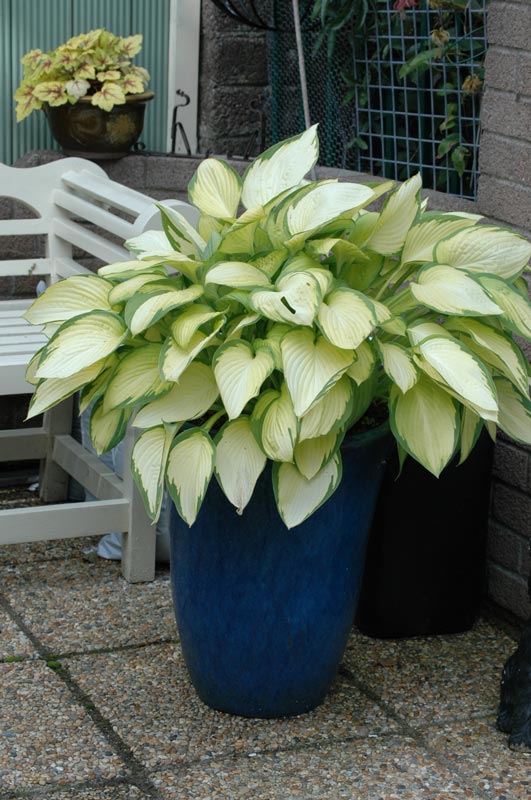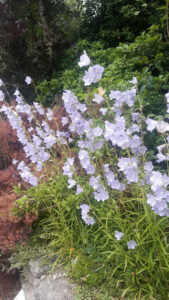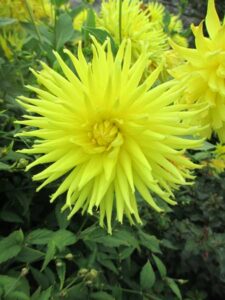GONE TO POT
In gardening, less can sometimes be more, and many beginners tend to over-plant and over-ornament. It is a mistake to introduce too many ideas, objects, or plants into too small an area. Most properties are small these days and there’s a natural tendency to want everything that takes one’s eye in other people’s gardens. As well, it is all too easy to divide up a garden into too many compartments, making it seem smaller than it actually is. Ease up I suggest over-heavy planting but increase the number of stopping points, and places of interest where one can sit and rest.
An easy way to create interest near garden seats and rest areas (and especially on balconies) is to use pots containing appealing and engaging plants. Herbaceous perennials are often neglected as suitable subjects, yet many lend themselves to simple pot culture. Let me give you a few examples.
Perennial wallflowers are made-to-measure container plants. Although they belong to the cabbage family (which make tap roots) in pots and containers their roots spread and divide. These evergreens often flower continuously through winter as well as summer but they’re probably at their best right now. Many have dark buds opening to paler flowers that become more colourful as they age. All are wonderfully fragrant. Erysimum Bowles’ Mauve is probably the best but ‘Plant World Lemon’ has flowers fading from pale yellow through bronze to mauve. Others are easily and cheaply sourced at garden centres.
Another good perennial is the Hosta. One plant on its own in a simple hand-thrown or glazed pot makes a spectacular sculpture, moving through a series of different forms from tight, sharp spikes to huge open leaves. Hosta ‘Gold Standard’ (illustrated) is a classic in our garden. Its elegant green/yellow foliage has a grape-like bloom from early spring to late autumn and elegant blooms in midsummer. Needless to say slugs would love it any night but to keep these rampaging gastropods away the pot is stood in a shallow tray of water to make a simple ‘moat’.
Heucheras which I have covered in the past but don’t forget that all are ideal when cultivated in pots and they have a range of qualities with which to bamboozle us. Apart from the fact that this family of ornamental foliage plants came through the last two winters here at Villa Marie without as much as a damaged leaf, their foliage is endlessly colourful, it has a good texture and the ‘foam flower’ (its colloquial name) always looks elegant and stylish. Best of all, they extract very modest demands on the compost and the prevailing conditions of sun or shade. Generally, heucheras do best in light shade during the hottest part of the day for full sun would burn and discolour its foliage during very hot spells. Dappled shade therefore suits them admirably. The worst insect pest on these is vine weevil but they’re easily controlled with Provado Vine Weevil Killer. My personal heuchera choices include; ‘Tiramisu’, ‘Lime Cordial’, ‘Marmalade’ and ‘Electric Lime’ but believe me no variety will be found less than good.
THE JUNE GARDEN 2023
JUNE is surely the most effervescent and ebullient month of the year. Growth is frothing and the sensation of newness abounds in the hedgerows and all through the countryside. In the garden, miracles are now a daily occurrence. Swollen buds on a tree peony opened only recently to reveal resplendent flowers and I had the privilege of not alone holding it in my hand but drinking in its perfume whilst marvelling at its very existence but wondering at its fragility. Yes, miracles are to be found in all gardens this month.
HERBACEOUS plants (and in particular lilies) should be watched carefully and their stems tied as they develop, otherwise they may be damaged by wind and wet conditions. Link Stakes are still one of the best options for neatness and practical support for floppy plants but bamboo can be used, so too pea sticks, pushed in among lengthening stems and growths. Be on the lookout for bright red lily beetles and pick these off once noticed. An infestation would quickly defoliate an entire stand of lilies. Dot confuse these with Ladybirds/ Lily beetles have no spots, are generally oblong and raise their young in black droppings.
SWEET PEA; Beware dryness at the roots of sweet peas. Never allow them to go short of water and feed them regularly with a liquid fertiliser. I like to use liquid feeds, especially those based on seaweed, during the period May to late June, thereafter liquid tomato food, as often as needed. Flowering will then be generous and prolonged.
DAFFODILS; Remove the foliage of daffodils now that June has arrived. If clumps have been growing in the same spot for a number of years and are not flowering well, then overcrowding may be the cause and now is the optimum time for tackling the problem. Lift and divide the daffs, replanting immediately the fattest, more substantial bulbs. Keep two inches between these. Excess stock can be used in new planting positions.
APHIDS; Watch for aphids and greenfly on roses and other ornamentals including lupins. Regular spraying may be necessary to prevent damage and poor flowering. The insects can usually be found feeding on the young shoots especially towards the tip of all soft growths. If you want to remain chemical-free, try using a good squirt of washing-up liquid mixed with a few litres of water applied where needed.
ROCK ROSES; The ’tissue paper’ flowers of Cistus (rock roses is their common name but they’re not true roses as we know them) are charming, especially those which are white with carmine red centres. They may be as large as three inches across and although they last but for a day at a time, the shrub will produce them in great numbers for up to two months in summer. Ideal for clothing sloping banks, steep inclines which cannot be grassed, or hungry dry sites, the plants are best bought in bloom for their colours will then be evident. Be warned however that they resent being transplanted or pruned. Once you decide on a sunny, well-drained position and planting has taken place, leave well alone.
CLEMATIS; Here’s a bright idea you might like to copy. Next time you visit your local garden centre see if you can source a clematis called ‘integrifolia’. This delightful variety from central Europe enjoys full sun and is ideal for a border among other perennials for it only grows to about three feet with a similar spread. It’s captivating two inch mid-blue, bell-shaped flowers formed from four petal-like sepals, appear from mid-summer to early autumn. It flowers on the current year’s shoots so should be cut down to a pair of buds six inches above ground in very early spring. The leaves are mid-to-dark green and the flowers are followed by silvery brown seed heads. This clematis likes fertile, humus-rich soil which drains easily. Failing this, any of the Raymond Evison clematis (from Guernsey) will certainly delight for they grow and flower at around six feet or less and be ideal for training up through low-growing shrubs. Try one on a metal or willow ‘tepee’ and you’ll have a feature as well as enchanting blooms for much of summer and autumn.








